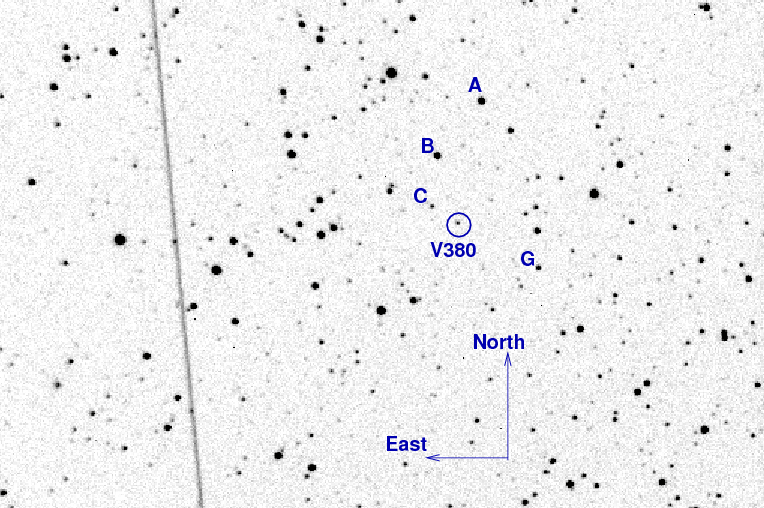
On the night of Aug 15/16, 2012, RIT Physics major Alex Habermann and I observed the variable star V380 Ophiuchus in order to support upcoming HST observations of the star. See the UT Aug 08, 2012 notes for details on the campaign.
The setup was:
Notes from the night
This is a chart of the field of V380 Oph, based on a SINGLE 30-second exposure taken during the night. The field of view is about 14 by 10 arcminutes.

Note that V380 Oph appears clearly, roughly as bright as star C. It is much brighter than it was on UT Aug 08, 2012.
The AAVSO provides magnitudes for a number of stars close to the variable star -- see their web site's Variable Star Plotter (VSP). I'll use the stars marked "A" and "G" above as my primary comparisons. According to the AAVSO,
Label V ------------------------ A 13.30 G 14.98 ------------------------
The overall sensitivity of the unfiltered CCD, telescope, etc., is probably not too far from that of the V-band. I measured instrumental magnitudes for stars in each individual image using simple aperture photometry with a radius of 3 pixels = 5.6 arcseconds and sky defined by an annulus around each star. Following the procedures outlined by Kent Honeycutt's article on inhomogeneous ensemble photometry, I used all stars available in each image to define a reference frame, and measured each star against this frame.
The difference between the mean instrumental magnitudes of stars A and G and the AAVSO V-band measurements were 11.31 and 11.36 mag, respectively. I deduced an offset of 11.33 mag -- but remember that the observations are unfiltered, not V-band. Using that offset, and the instrumental magnitude of V380 Oph, one can derive an approximate V-band magnitude of V = 16.1.
I sent a message to cba-data with the following report.
# Measurements of V380 Oph made at RIT Obs, Aug 16, 2012 UT, # in good conditions, # by Michael Richmond, using 12-inch Meade LX200 and SBIG ST-8E CCD. # Exposures 21x30 seconds long, no filter. # Tabulated time is middle of span of co-added exposures. # 'mag' is a differential magnitude based on ensemble photometry # using a circular aperture of radius 5.5 arcseconds. # which has been shifted to match AAVSO V-band magnitudes # for several nearby comparison stars. # # UT_day JD HJD mag Aug16.08300 2456155.583 2456155.586 16.1
Alas, this will be the last observation of V380 Oph we make during the current season. The goal was to see if the star was in its low state, which would allow HST to make measurements of the white dwarf member of this binary star. Joe Patterson sent the following message to CBA members last night, after I had finished making measurements:
We're satisfied now that V380 Oph is only in a semi-low state, not a really deep low state, which would have warranted an HST observation. So: job well done. However, before concluding it, could someone get a long time series? The snapshot data suggested there may be a periodic signal there - could someone check?
Oh, well.
Last modified 08/16/2012 by MWR.